Raichka (Raissa Lichtenstein)
(1896-1988)
Last photo of Raichka: with me in Salisbury hospital, 1988. She was aged 91 and died a few weeks later on December 21st.
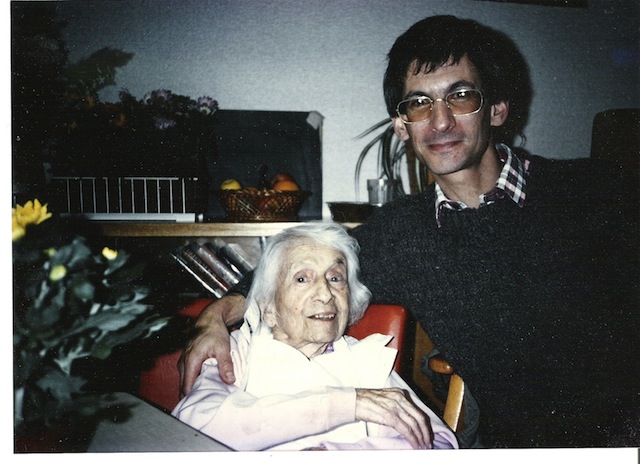
Sestroretsk, 1898 - 1916
My grandmother Raissa was born on December 22nd 1896. Her father, Matio Lichtenstein was a German medical doctor; her mother Eugenie (Genia) was Russian. Raissa had five siblings: Dina, Moussia (Mary), Tamara, Leo and Mischa (Michael).
Matio and Genia, Raichka’s parents.
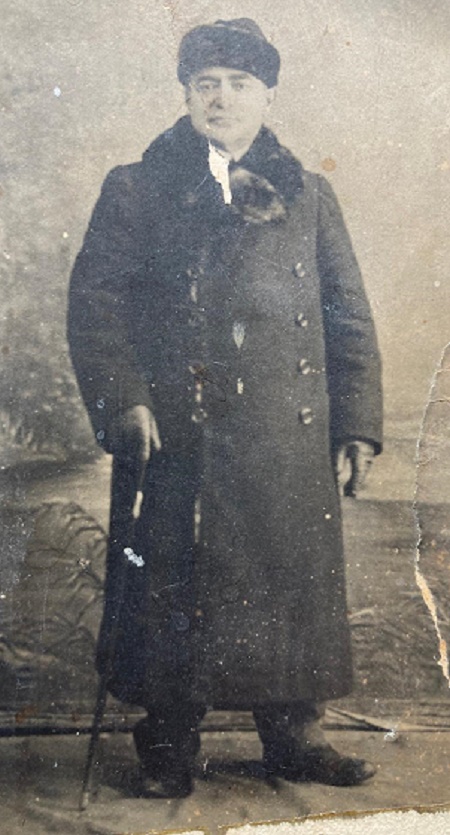
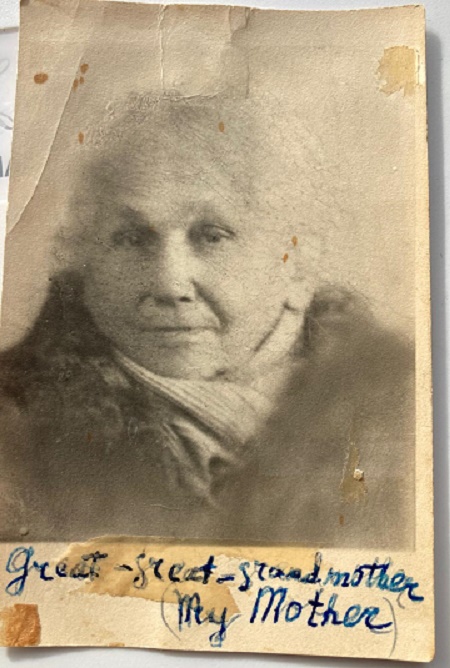
It was not at all unusual for doctors in the Russian Empire to be German. Indeed “the words ‘German’, ‘Doctor’ or ‘Pharmacist’ used to be synonymous in Russia. German Doctors had been active in Russia since before the 15th century. Later they established medical institutions like pharmacies or hospitals.” (link)
Raichka grew up mainly at Sestroretsk, where her father worked at the sanitorium. Sestroretsk is 34 kilometers (21 mi) northwest of St. Petersburg, and is located on the shores of the Gulf of Finland, the Sestra River and the Sestroretskiy Lake, The town is still known as a balneologic (spa) and climatic resort, and a large hospital and rehabilitation centre is situated within the boundaries of the town. (link)
The resort at Sestoretsk was founded in 1898, so if Dr Lichtenstein obtained his position at the beginning Raichka would have been less than two years old when the family settled there.
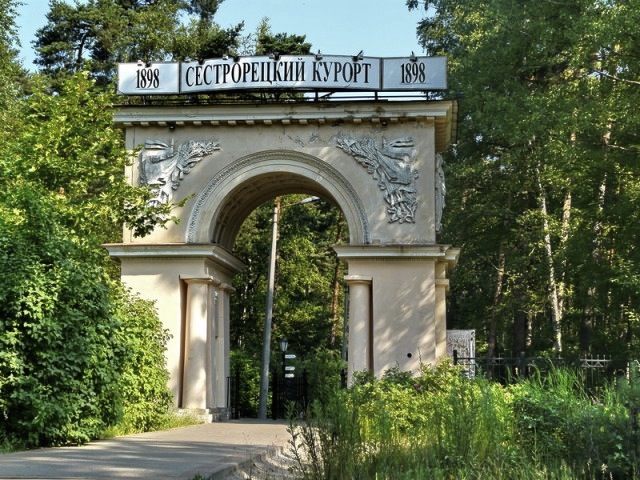
Photo credit Vitaly Bichayev
This is the front gate of Sestroretsk resort. The resort was opened in 1898. The gates were built in the late 50’s of the 20 century. Pure pine air, sand dunes, endless expanses of the Gulf are attracting thousands of residents of Petersburg.
The Tunguska event of 1908
I happen to be writing this two weeks after the Russian meteor blast which injured 1000 people in February 2013, said by NASA to be the largest reported fireball since the Tunguska event of 1908. Scientists believe that on the morning of June 30, 1908, a large space rock, about 120 feet across, entered the atmosphere of Siberia and then detonated in the sky, several miles above the Earth. It is estimated the asteroid entered Earth’s atmosphere traveling at a speed of about 33,500 miles per hour. During its quick plunge, the 220-million-pound space rock heated the air surrounding it to 44,500 degrees Fahrenheit. At 7:17 a.m. (local Siberia time), at a height of about 28,000 feet, the combination of pressure and heat caused the asteroid to fragment and annihilate itself, producing a fireball and releasing energy equivalent to about 185 Hiroshima bombs. (NASA link) It estimated that perhaps 80 million trees were flattened and livestock were killed over an area of 800 square miles.
In 1908 St. Petersburg was the capital of Russia with a population of a few hundred thousand. It has been calculated that if the asteroid had arrived four hours and fifty-two minutes later it could have hit St. Petersburg: the city would have ceased to exist.
This photograph, taken before 1917, shows the train which linked Sestoretsk with St Petersburg.
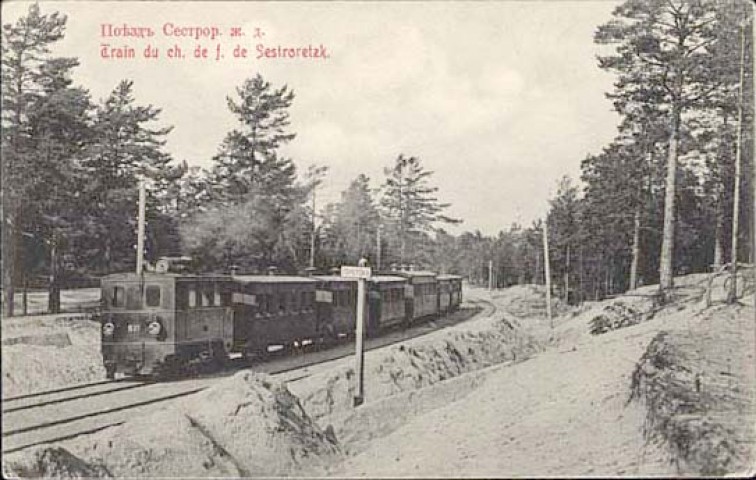
Meeting David Sisserman in 1916 - and marriage
Raichka wrote a very romantic account of her meeting David Sisserman in the summer of 1916. She daily attended the concerts of the Preobrajensky orchestra, near the beach at Sestoretsk, accessed by walking through the pine forest from her father’s sanitorium. She was introduced to David, who walked Raichka and her brother home, and then had to stay overnight due to a thunderstorm. Raichka’s mother found David sleeping in the bed of another brother. In the morning David played the cello to the family; he had already proposed marriage!
This is an illustrated account of that first meeting:
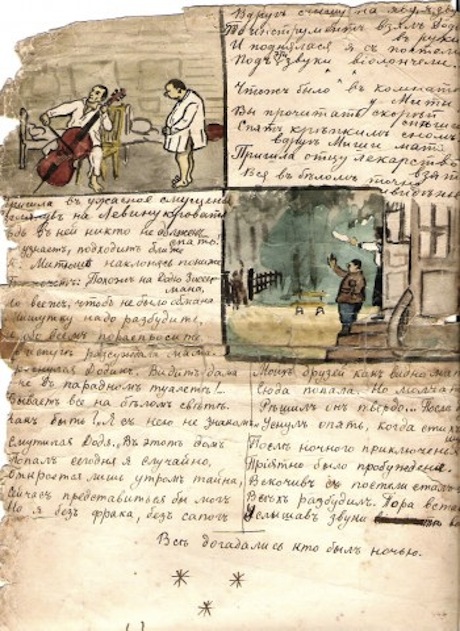
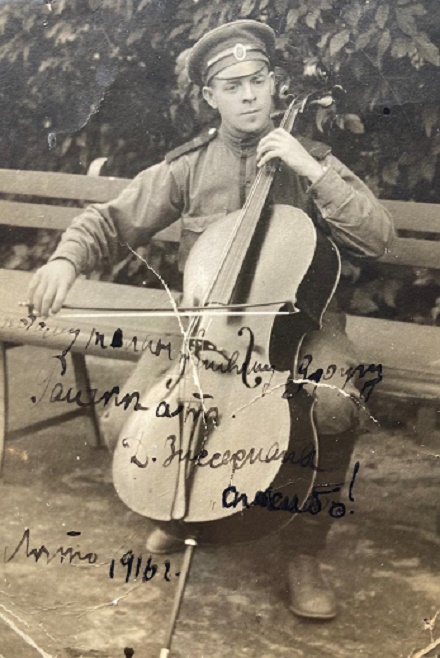
Click here to download Raichka’s fuller account of their meeting, in her biography of David Sisserman.
Travel from Petrograd to Rostov, July 1917. After the February revolution, David continued to play with the Preobrajensky orchestra, which was sent to Rostov - where they arrived the day before the birth of George (11 July 1917). David became a Professor at the Rostov Conservatoire. Raichka’s mother advised them not to return to Petrograd but to stay in the South of Russia, but Rostov too was in a constant state of siege, changing hands between the Red and White armies 4 times in a year. Raichka and David were on the side of the Whites.
Click here to download Raichka’s own account.
October 1917: Requisition of the Sestroretsk sanitorium and death of Raichka’s two brothers
This is in Raichka’s biography of David Sisserman:
After the revolution of October 1917, all money was a valueless heap of printed paper. The newly formed Government of People’s Commissars requisitioned private property from the “bourgeoisie”, and Dr. Matio [father of Raissa] lost his beautiful sanitorium by the Finnish Bay in Sestroretsk. All the valuable possessions like silver, carpets, priceless Persian rugs and the rest of the family treasures were packed away and stored in the attic – the entrance to which was cleverly papered over to match the wallpaper of the upstairs room. This attic was converted into 3 large bedrooms for the family, one for the four girls, another for the two boys, the third room for mother and Dr. M. If we ever came back to our home (as everyone hoped at that disastrous time) we would get all our treasures back! We hoped that one day we would return to our home and find our “secret place” undiscovered …
But it was only a hope. Our devoted manservant-gardener was helping the family in this strictly confidential ritual. And this servant was actually the victim of Bolshevik propaganda, which urged all servants to spy on their masters, promising a big reward for the location of any hidden valuables. Arnold, the gardener, looted the sanatorium, carted away beds, carpets, my piano and music, a large assortment of furniture, etc. We could make no claim for compensation …
In the nightmare of class rule, my two brothers lost their lives in their early 20s. During the epidemic of arrests, Mischa and Leo were in a group of a few dozen young people who got together for a jolly evening which was not authorized, listening to music and telling jokes. They were arrested, and some disappeared, including my brothers M. and L. “You are under arrest!” “Me? What for?” They had no time to register those they had arrested … M. and L. disappeared for ever.
In April 1917, when Lenin and his comrades had made the 2,000 mile eight-day rail journey from Zurich to St Petersburg, they passed through Sestroretsk where “the platform was crowded with a large party of jubilant workers from the Sestroretsk munitions plant several miles away. They lifted Lenin shoulder high as he stepped from the carriage, much to his surprise”.
A first-hand account of a family whose allegiance was also to the Whites - and their allies from Britain and other interventionist forces - is given in Eugenie Fraser, “The House by the Dvina: A Russian Childhood” (Corgi Books, 1986). Fraser was born in 1905. From p.191 she covers the start of World War I, the February 1917 ‘revolution’, and the Civil War up to her departure with her Scottish mother in 1920. In an epilogue on the Civil War she writes:
Never since the dawn of Russian history had there been such a time of fear, grief and horror - a time described by the poetess Akhamatova as ‘When only the dead could smile’.
David to Novorossiysk and Odessa. David travelled with his quartet to Odessa, where he was again appointed to the Conservatoire. Chaotic conditions of Civil War continued, Odessa being under the White army but fearing the arrival of the Reds any day. David wrote to Raichka asking her and George to join him in Odessa.
Click here to download Raichka’s account.
Raissa travels from Rostov to Novorossiysk March 1919. Raichka and George travelled by train to Novorossiysk.
Click here to download Raichka’s account.
Raissa travels from Novorossiysk to Odessa April 1919. They travelled to Odessa on the boat “Konstantine”. Stopping in Yalta, Raichka visited a market with George and an apprently friendly soldier, and had a harrowing time when she became separated from them ….
Click here to download Raichka’s account.
David and Raissa reunited in Odessa. Raissa and George arrived in Odessa on the eve of its falling into the hands of the Red Army. Still on the boat in port, she employed a tramp to send a message to David ….
Click here to download Raichka’s account.
David and Raissa’s life in Odessa. Musicians were now working for the Bolsheviks and performing at “Meeting concerts” - drawing people with free concerts to attend political speeches. David, Raichka and George lived initially as tenants in a requisitioned house.
Click here to download Raichka’s account.
Visit to the salt lakes. When David’s Petrograd Quartet travelled for a concert, they took the opportunity to engage in the Black Market for salt and sugar, even though discovery would result in execution by the Bolshevik authorities.
Click here to download Raichka’s account.
David and Raissa in house of engineer, Odessa. In 1920 the Petrograd Quartet was fortunate to take over the large and beautiful house of an engineer. Here their Tuesday concerts became a refuge from the reality of daily life, where everyone had a loved one who had been executed or was “missing”. David and Raichka longed to leave Russia.
Click here to download Raichka’s account.
Attempt to leave Russia from Odessa. A German Red Cross nurse in Odessa managing exchanges of prisoners of war was running a racket selling false passports. David paid her to prepare a German passport so that he could leave Russia, but when the nurse was arrested David’s passport was discovered, he was summoned for interrogation at at the Cheka and imprisoned.
Click here to download Raichka’s account.
David in prison in Odessa. David spent several weeks in appalling conditions. According to Raichka his release, at the time of a prisoner amnesty on the occasion of the Anniversary of the Revolution, was due to the fact that an official handling the prisoner releases was known to Mme Chernetzkaya-Geshelin, pianist with the Petrograd Quartet.
Click here to download Raichka’s account.
From Odessa to Petrograd. Click here to download Raichka’s account.
In Petrograd. Click here to download Raichka’s account.
Visit to Murmansk. Click here to download Raichka’s account.
Back in Petrograd. Click here to download Raichka’s account.
Leaving Petrograd - to London via Berlin 1923. Click here to download Raichka’s account.
On the back of this photo Raichka wrote: “At last England!! 1924”
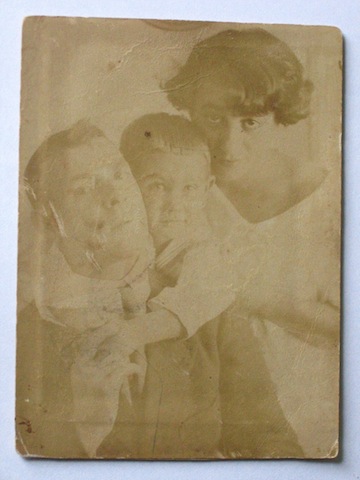
In London from 1923
Soon after arriving in London, Raichka was walking with the six-year-old George when they encountered a woman with a small daughter … speaking Russian! The women fell into each others’ arms and became lifelong friends: this was Bertha Fox and her daughter Elenor.
In October 1924 David Sisserman (“Professional Cello”) appeared in the London phone book at 89 Sutherland Avenue, Maida Vale; from October 1925 to 1929 the Sisserman address was nearby 25 Biddulph Mansions. (At this time David’s brother Michael Zacharewitsch was living nearby at 140a Elgin Avenue; in the 1930s Michael lived in Golders Green, at 3 Garrick Avenue.)
In 1929, while David Sisserman was in Australia, Shura Cherkassy, the 20-year-old piano virtuoso from Odessa, lodged with Raichka in London; there began a friendship which lasted nearly 60 years until her death in 1988.
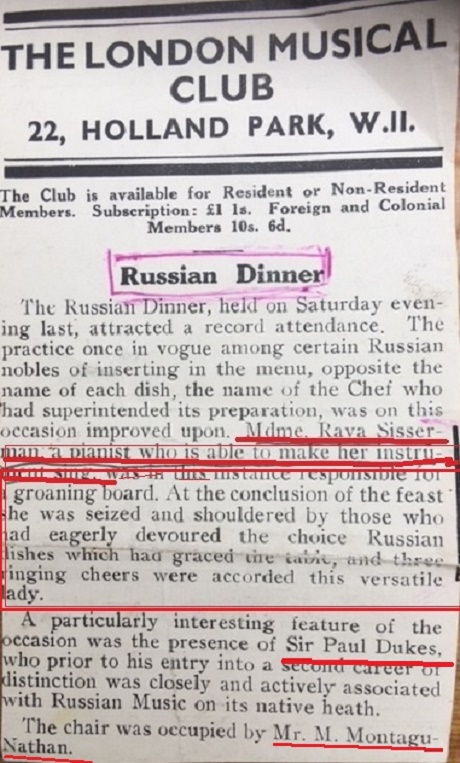 There is no date on this press cutting, but the London Musical Club was founded in 1931 by A. Adela Hamaton when she retired from her position as Principal of the Middlesex College of Music (where David was employed until 1929). The Club “was designed as cheap accommodation for struggling music students or those visiting London for auditions. The combination of space for living and instrumental practice proved to be popular and attracted musicians from around the world.” (Laura Seddon, ‘British Women Composers and Instrumental Chamber Music in the Early Twentieth Century’, Routledge, 2016.) Sir Paul Dukes worked at the Petrograd Conservatoire before the Russian Revolution, was recruited by MI6 and continued to work as the sole British agent in Russia until 1920.
There is no date on this press cutting, but the London Musical Club was founded in 1931 by A. Adela Hamaton when she retired from her position as Principal of the Middlesex College of Music (where David was employed until 1929). The Club “was designed as cheap accommodation for struggling music students or those visiting London for auditions. The combination of space for living and instrumental practice proved to be popular and attracted musicians from around the world.” (Laura Seddon, ‘British Women Composers and Instrumental Chamber Music in the Early Twentieth Century’, Routledge, 2016.) Sir Paul Dukes worked at the Petrograd Conservatoire before the Russian Revolution, was recruited by MI6 and continued to work as the sole British agent in Russia until 1920.
In 1932 the electoral register showed David and Raissa Sisserman at 124 Inverness Terrace, Lancaster Gate, W2. In 1934 (when David had returned to Australia) Raissa and George were at 37 Greencroft Gardens, South Hampstead, and in 1935 at 10 St Andrew’s Road, Golders Green. By 1936 they had moved to 36 Leinster Gardens, Lancaster Gate (close to their earlier address in Inverness Terrace), and this was the address recorded on the ship’s manifest when David Sisserman visited from Australia in 1938. (David was on the electoral register with Raissa in 1938, but - significantly - not in 1939.)
Shortly before the marriage of George and Nora in June 1940, Raichka moved to Flat 2, 71 Hamilton Terrace, Maida Vale. Nora said:
And we knew that Grandpa would be going in the army very shortly so we decided that Raichka and I would live together. And we found a flat in Hamilton Terrace … Oh it’s marvellous – where Lords Cricket Ground is, they’re very big houses. And we took it really, the flat, to have the wedding reception there because it had an enormous lounge, and we didn’t need to hire a hall or anything…. And we had plenty of room – you’ve seen the thing where everyone signed their names?
Nora’s brother Henry Mayer, after returning to his RAF base after the wedding, wrote on 1st July 1940:
My dear Nora and George, I feel I must just write you a line to tell you both how very much I really enjoyed the week-end and also especially to congratulate you on the organisation of the reception, and I think most praise of all is deserved by your mother George …
In the early 1940s, when George was posted with the army to Aberystwyth in North Wales and Nora was able to rent accommodation in the town, Raichka went up with her. Raichka and Nora then returned to Maida Vale, London, but moved from Hamilton Terrace nearby to 67 Rodney Court; they were living there when my brother David was born in April 1943.
In 1944 Nora and David left London for Bournemouth (where I was born), and we lived there until our departure for Berlin in December 1946. When my parents, brother and I returned from Berlin late in 1947, Raichka let us take over Rodney Court, and she moved to what George called a “flatlet” at 11 Buckland Crescent, Belsize Park, Hampstead, courtesy of Bertha Fox, the Russian friend she had met soon after arriving in London in 1923. Raichka’s name appears at this address on the electoral register for 1948, but as Raissa Seymour - she was no longer using the surname Sisserman.
In September 1949, when we moved out to a new house - Tudor Gardens in suburban Kingsbury - Raichka moved back to 67 Rodney Court, and this address was recorded on the ship’s manifest when she set sail for New York on 5th June 1951.
Los Angeles 1951-1956
On 31st August 1951 Raichka married her second husband, Morris Hildes, in Beverly Hills, California. Morris Hildes was born Moishe Zanwelt Hildesheim in Palestine in January 1887, arrived in the USA in 1920, and was naturalised in Chicago in 1926.
Morris had met Raichka when he visited a brother in England who was a friend of Raichka. This was Pierre Gildesgame, president of the Maccabi Association until his death in 1981. Pierre Gildesgame owned a company which manufactured garments for Marks and Spencer. His brother Leon Gildesgame had run the company with Pierre but emigrated to New York after World War 2. Pierre Gildesgame was born in Poland in 1903 and spent World War 1 in Palestine. In 1915 his brother Leon (as Elie Hildesheim) had fought at Gallipoli.
After her marriage to Morris Raichka was known as Raissa Seymour-Hildes and lived at 414 South Willaman Drive, Los Angeles 48. In April 1953 she sailed (without Morris) First Class from New York to England. (On the same ship were Osbert and Edith Sitwell.)
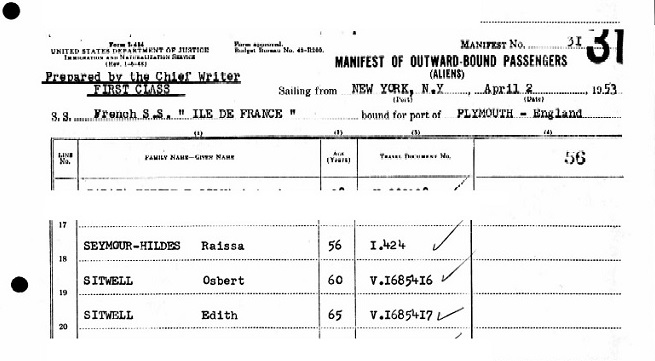
Raichka was in England for five months, returning to the U.S. in September 1953. The ships’ manifests record her as aged 56, place of permanent residence the USA, and profession “housewife” (though I believe she contined to work as a piano teacher in California).
This picture dated September 1953 was sent to “our dear Sonia and Mischa” - Sonya Chamina and her husband.
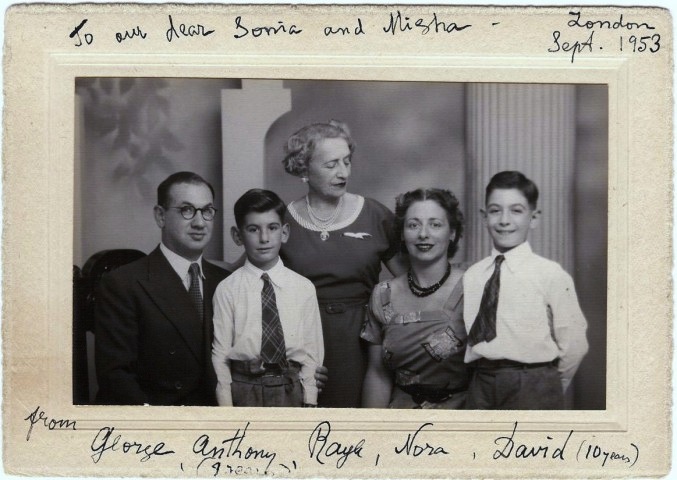
On 22nd July 1955, at the age of 58, she was naturalised as an American citizen in California.
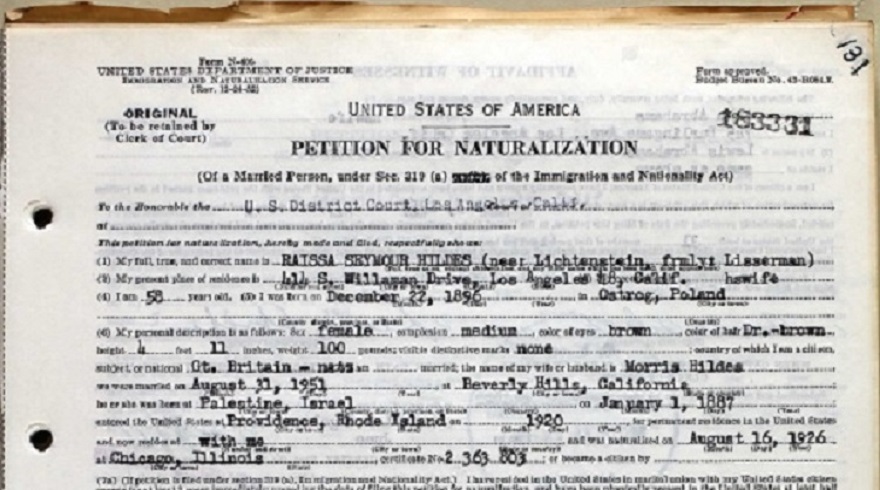
Back in England 1956 - 1988
On 24th July 1956 Raichka arrived - this time with Morris Hildes - in Southampton on board the SS United States from New York. Although the intended length of their stay in the UK (again at 25 Tudor Gardens, London NW9) was “indefinite”, their country of future residence was listed on the ship’s manifest as the USA. But Raichka and Morris were to leave the USA permanently, and bought a house not far from us, 16 Highfield Avenue, London NW9. Raichka appears on the electoral register at this address from 1958 to 1965.
Morris Hildes died in 1967 at the age of 80. Raichka sold their house and moved to a flat at 38a Boycroft Avenue, NW9. In the 1970s Nora and George moved from Tudor Gardens to a larger, detached house: 18 The Paddocks, Wembley Park (also not far from NW9). In the mid-1970s George had to retire early owing to ill health, Nora returned to work as a legal secretary at the age of 60, and Raichka moved into their house at The Paddocks.
In 1983 Nora and George downsized, moving from The Paddocks to a flat in Stanmore, Middlesex. Raichka had taken several holidays on the south coast at Barton House, Barton on sea, near New Milton, Hampshire, which since 1954 had been used by the British Council for Aid to Refugees “as a home for displaced people from Eastern Europe”. Having arrived as a refugee in 1923 (!) Raichka qualified and moved into Barton House, where she lived for the last five years of her life.
Raichka died on December 21st 1988, one day before her 92nd birthday.
Page last updated 28 Sep 2024.